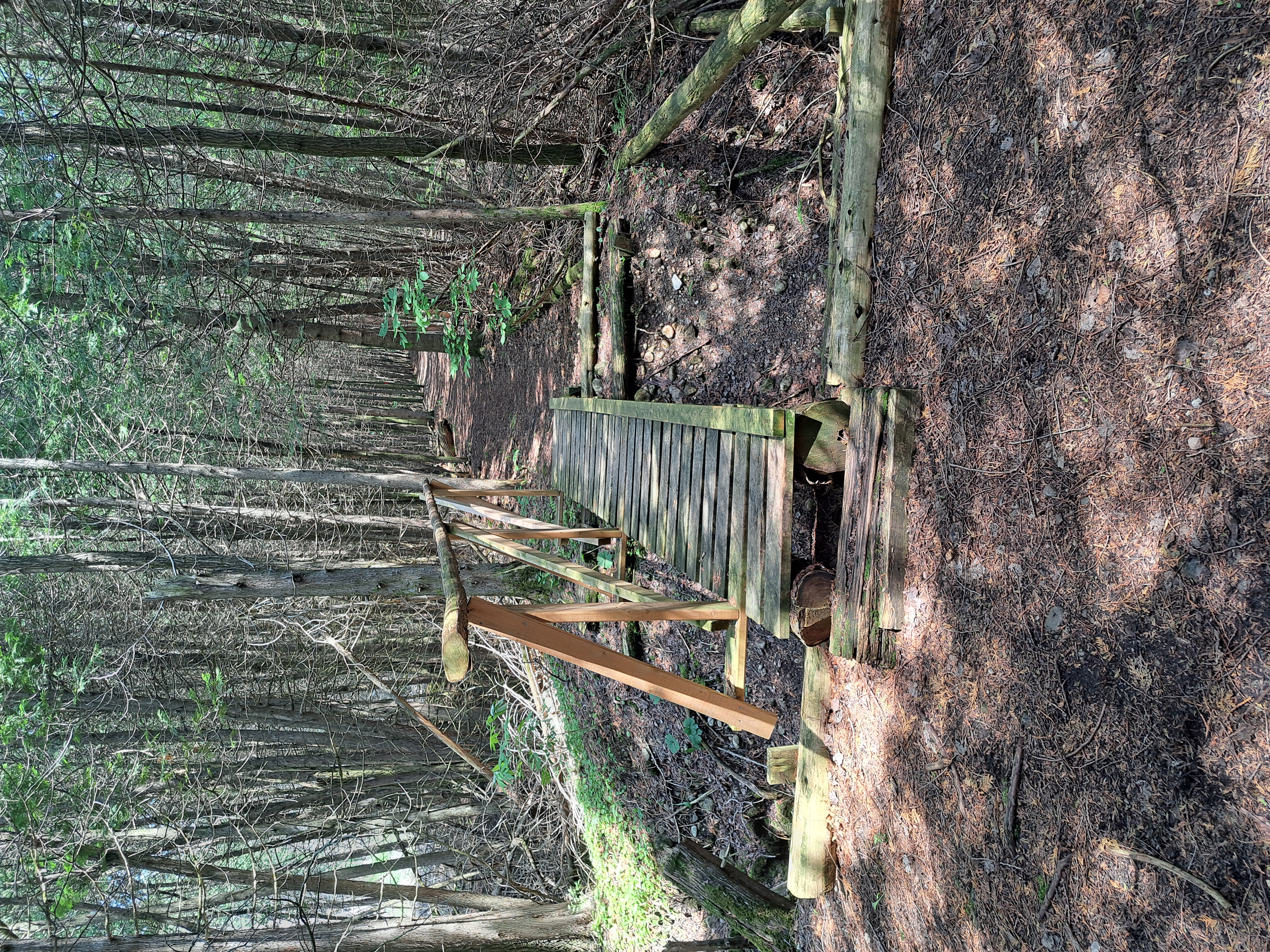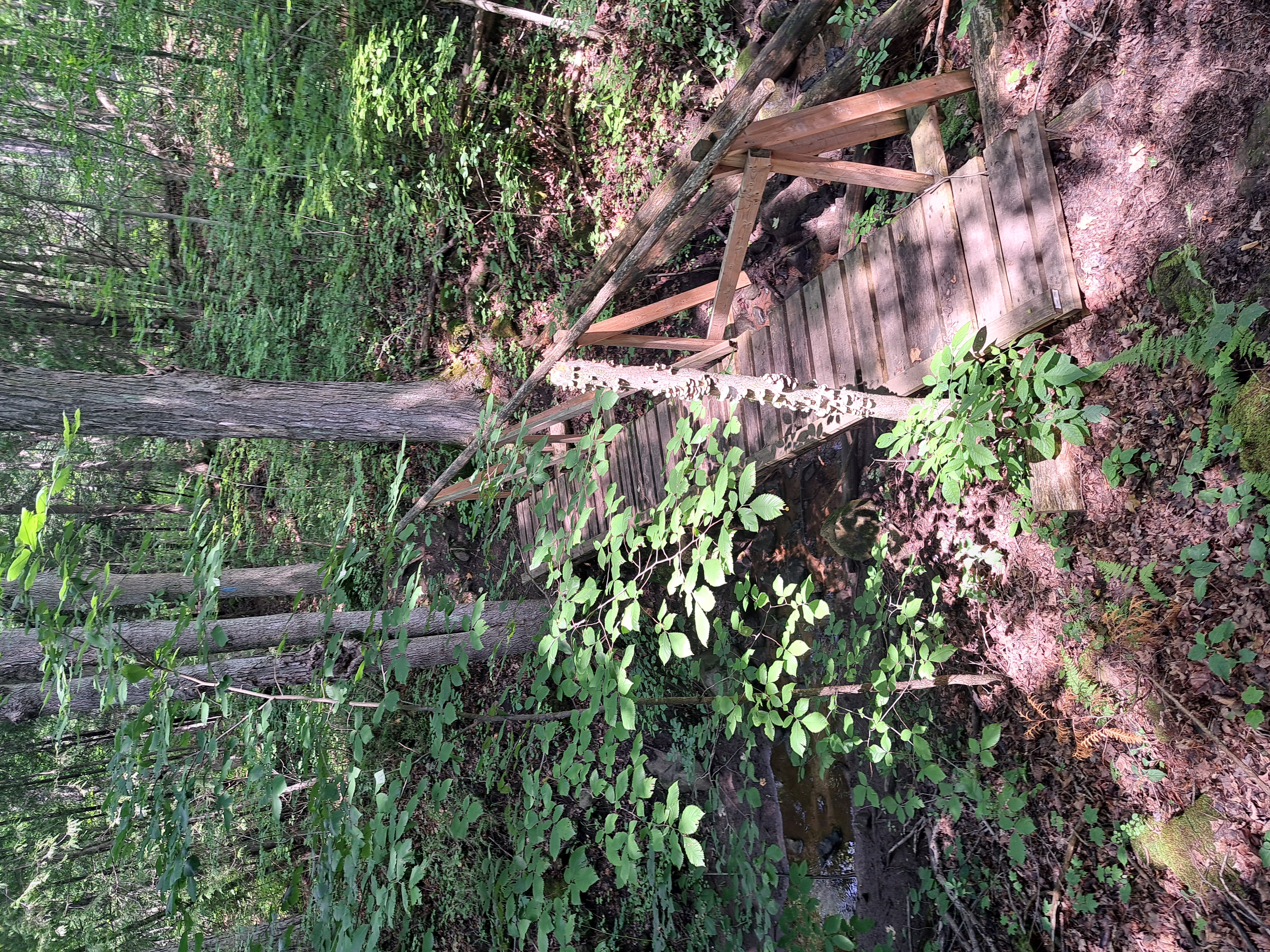|
- Home
- Trails
- Year of the Bridges
- RLT Sec 5 Bridges
Radial Line Trail, Section 5 Bridges
By Liam Waterman, GHTC Volunteer


Aside from the boardwalk, there are also a number of bridges built by the Guelph Hiking Trail Club (GHTC) located on section 5 of the Radial Line Trail (RLT). These include three wooden footbridges on the portion of this section that follows the bed of the former Radial Line, covering, respectively, a large depression in the trail, a small stream feeding into Blue Springs Creek, and a relatively minor dip at the beginning of the Beaver Pond side trail. There are also two repurposed steel bridges covering small streams on the Beaver Pond side trail, and another wooden footbridge on the nearby Blue Springs side trail, spanning another small stream. The wooden footbridges on this section were recently repaired during a string of work parties in the fall of 2017, which saw the addition of handrails to each bridge and the replacement of any decaying boards or logs.1 Thanks to these repairs, the bridges on section 5 remain some of the oldest footbridges still in use on GHTC trails, dating back at least to the 1980s.
Partly as a result of their age, the precise origin of these bridges is unfortunately somewhat unclear. In the process of gathering information on the various connective structures built by the GHTC for the #YearOfTheBridges, I have had the privilege of interviewing a number of longtime GHTC members who have been heavily involved with the club’s work in trail maintenance.1 Regarding the section 5 bridges, I talked to former RLT trail coordinator and current section 5 leader Phil Kidston, who suggested that the two wooden footbridges on the rail bed to the west of the boardwalk, along with the wooden footbridge on the Blue Springs side trail, were likely built sometime during the 80s under the oversight of Andy Cann. Andy has formerly served as section leader for many different portions of the RLT, and over the course of several decades has worked extensively not only to maintain but also to expand and improve large sections of the RLT. He was responsible, for instance, for creating what is now the eastern half of RLT section 5, which passes over the boardwalk and travels southeast towards sixth line Nassagaweya.2
The first of these bridges to the west of the boardwalk on the rail bed on section 5, which covers a large depression (likely the location of a former railway culvert), was most certainly constructed by Andy. Phil specifically remembers talking with Andy sometime in the 80s regarding his plans to put a bridge in this location; since the depression was much shallower at the time, Phil had questioned the necessity of the bridge. As he recalls, Andy had suggested that it would serve to make the trail less treacherous in cases of rain, since the sides of the depression could become particularly slippery. Time seems to have proven Andy right, as the depression has deepened significantly over the years, making the bridge essential. The bridge itself consists of two cedar logs laid lengthwise as stringers, with cedar decking boards laid overtop. This is a design shared by the other wooden footbridge on the rail bed to the west of the boardwalk, along with the wooden footbridge on the Blue Springs side trail. The other footbridge on this side of the railbed seems to have been constructed around the same time, so it is reasonable to suppose that Andy would have been involved with it as well. The bridge on the side trail, by contrast, was likely built several years later, since the trail itself was not created until the 90s. Nonetheless, it is entirely likely that Andy was involved with or even initiated the construction of this bridge as well, given that he was responsible for creating the side trail, and served as section leader for the “Blue Springs Loops” for a number of years.3
Unlike the others, the wooden footbridge on the rail bed to the east of the boardwalk was built by local teacher Chris Walker. Though not a member of the GHTC, Walker was heavily involved with maintenance of the Bruce Trail, and at one point during the 90s brought his class to RLT section 5 to construct this bridge, with Phil’s permission. The bridge utilizes, again, two cedar logs laid lengthwise as stringers with decking boards on top. The utility of the bridge is somewhat dubious; it covers only a very slight dip in the trail, which is not prone to significant flooding. Phil conjectures that the bridge may have been a kind of “make work” project. The origin of the final two steel bridges further along on the Beaver Pond side trail, which appear to have been brought in second hand, is completely unclear. The steel bridges were definitely present by the year 1990, but could feasibly have been introduced as early as the 1970s, since the current Beaver side trail, formerly the main trail of RLT section 5, has remained unmoved since the initial creation of the RLT itself.
Regardless of their origin, all of these bridges have lasted for an impressive number of years without problems. It was only in 2017, as the wooden footbridges began to exhibit signs of decay, that the GHTC decided some repairs were necessary. There were particular concerns, during this period, that the slipperiness of these bridges could become a potential safety risk. Phil Kidston, then section leader, and John Fisher, then trail coordinator for the RLT, organized work parties during the fall of 2017 in response to this potential danger, with the goal of adding handrails to all of the wooden footbridges present on RLT #5.4 These handrails were constructed using local cedar logs, supported by wooden plank trusses extending at the ends and midpoint of each bridge. These work parties also added an additional thin wooden plank running on the surface of each bridge opposite the new handrails, which would serve to prevent users’ feet from slipping off.
In the course of making these additions, the volunteers took the time to replace any decking boards or stringers that were rotting or otherwise in poor repair on any of the wooden footbridges. In the case of the footbridge on the Blue Springs side trail, for instance, which was repaired by Phil Kidston, Fraser Brown, John Fisher, and Mike Curtis, the cedar log stringers underneath happened to be in a state of serious decay, prompting the volunteers to replace them with new cedar logs. The prevalence of cedar nearby reduced the amount of materials that needed to be brought in from outside. John Fisher particularly recalls cutting down cedars at the top of the hill above the Blue Springs side trail footbridge and hauling them down to be used on the bridge. Nonetheless, some boards did have to be purchased, which were then brought in by wheelbarrow. Thanks to these repairs, all of the bridges on section 5 of the RLT remain structurally sound and secure for the foreseeable future. Though their origins are somewhat obscure, they certainly have not been forgotten about by the GHTC. Much like the club itself, these bridges have changed over time, but have yet to fail in their role serving recreational users and allowing access to these wonderful trails.
Notes
1. In addition to my interview with Phil Kidston, I also talked to John Fisher regarding the origin of these bridges, August 2023. I also inquired via email with Bob Fanning, who was involved with the initial creation of much of the Radial Line Trail.
1. Kidston, Phil. “Bridge Maintenance and Improvement,” Guelph Hiking Trail Club Newsletter 46, no. 1 (2018): 4, https://issuu.com/doberman_xy/docs/2018-03.ghtc_46_1.
2. “Guelph Trail Club Newsletter: November 1988, Volume 16 Number 4,” Minutes, Newsletters, Handbooks, Posters, Scrapbooks, Correspondence and Other Items Relating to the Guelph Hiking Trail Club, 1970-, McLaughlin Library, University of Guelph.
3. “Annual General Meeting: November 19, 1998,” Minutes, Newsletters, Handbooks, Posters, Scrapbooks, Correspondence and Other Items Relating to the Guelph Hiking Trail Club, 1970-, McLaughlin Library, University of Guelph.
4. Kidston, Phil. “Bridge Maintenance and Improvement,” Guelph Hiking Trail Club Newsletter 46, no. 1 (2018): 4, https://issuu.com/doberman_xy/docs/2018-03.ghtc_46_1.


